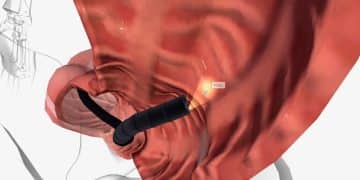New Non-Surgical Treatments for Peyronie’s Disease in the US

While surgery remains a primary option, several new non-surgical treatments for Peyronie’s disease are emerging in the US, offering less invasive alternatives like collagenase clostridium histolyticum (Xiaflex), vacuum erection devices, and various oral medications aimed at reducing plaque size and curvature.
Are there any new non-surgical treatments for Peyronie’s disease available in the US? The answer is yes, and these options are providing renewed hope for many men. Peyronie’s disease, characterized by the development of fibrous scar tissue (plaque) inside the penis that causes curved, painful erections, affects a significant number of men. While surgery has been a traditional treatment, emerging non-surgical approaches are gaining traction for their potential to reduce pain and curvature without the risks associated with invasive procedures.
Understanding Peyronie’s Disease and Its Impact
Peyronie’s disease can have a significant impact on a man’s life, affecting not only physical health but also emotional well-being and relationships. The condition is often marked by painful erections, penile curvature, and erectile dysfunction, making intimacy challenging and diminishing quality of life.
The Prevalence and Causes of Peyronie’s Disease
Peyronie’s disease affects an estimated 3% to 9% of men, although the actual number may be higher as many cases go unreported. The condition typically develops after the age of 40, but it can occur in younger men as well. The exact cause of Peyronie’s disease is not fully understood, but it is believed to involve trauma to the penis, leading to inflammation and the formation of scar tissue.
The Psychological and Emotional Toll
Living with Peyronie’s disease can be emotionally challenging. Many men experience anxiety, depression, and a diminished sense of self-esteem. The inability to achieve or maintain a satisfactory erection can strain relationships and lead to social isolation. Therefore, effective treatment options that address both the physical and psychological aspects of the condition are crucial.
The impact of Peyronie’s disease extends beyond the individual, affecting partners and relationships. Open communication and understanding are vital for couples navigating the challenges posed by this condition. Psychological support and counseling can also play an important role in helping men and their partners cope with the emotional aspects of Peyronie’s disease.
Current Non-Surgical Treatment Options in the US
Several non-surgical treatments are currently available in the US for managing Peyronie’s disease. These treatments aim to reduce pain, decrease penile curvature, and improve sexual function without the need for surgery. The effectiveness of each treatment can vary depending on the severity and stage of the condition.
Collagenase Clostridium Histolyticum (Xiaflex)
Xiaflex is the only FDA-approved injectable medication for the treatment of Peyronie’s disease. It contains an enzyme that breaks down collagen, the main component of the plaque. Treatment involves a series of injections directly into the plaque, followed by penile modeling to help straighten the penis.
Vacuum Erection Devices (VEDs)
VEDs are devices that create a vacuum around the penis, drawing blood into the area and promoting an erection. Regular use of VEDs can help to stretch and remodel the plaque, reducing curvature and improving erectile function.
Oral Medications
Several oral medications have been studied for their potential to treat Peyronie’s disease. These include:
* **Pentoxifylline:** This medication is believed to improve blood flow and reduce inflammation, which may help to break down the plaque.
* **Vitamin E:** Vitamin E is an antioxidant that may help to reduce scar tissue formation.
* **Potassium Para-Aminobenzoate (Potaba):** Potaba is an antifibrotic agent that may help to reduce the size and density of the plaque.
These non-surgical treatments offer hope for men seeking to manage their condition without surgery. It’s important to consult a healthcare professional to determine the most appropriate treatment plan.

Exploring Newer and Emerging Non-Surgical Therapies
Beyond the established treatments, there are several newer and emerging therapies that show promise for the non-surgical management of Peyronie’s disease. These treatments are often used in conjunction with existing therapies to improve outcomes.
Extracorporeal Shock Wave Therapy (ESWT)
ESWT involves delivering shock waves to the plaque to break down scar tissue and promote blood flow. While the effectiveness of ESWT is still being studied, some studies have shown promising results in reducing pain and curvature.
Injections of Verapamil or Interferon
Verapamil and interferon are medications that have been used to treat other fibrotic conditions. When injected directly into the plaque, they may help to reduce inflammation and break down scar tissue.
Topical Applications
Topical creams and gels containing medications like verapamil or superoxide dismutase (SOD) are being investigated for their potential to reduce plaque size and curvature. These topical applications are non-invasive and may offer a convenient treatment option.
Exploring these newer and emerging therapies provides additional options for men with Peyronie’s disease. Further research is needed to fully understand their effectiveness and safety.
Lifestyle Adjustments and Complementary Therapies
In addition to medical treatments, certain lifestyle adjustments and complementary therapies can play a supportive role in managing Peyronie’s disease. These approaches focus on promoting overall health and well-being, which can indirectly benefit the condition.
Diet and Exercise
A healthy diet rich in antioxidants and anti-inflammatory foods can help to reduce inflammation and support overall tissue health. Regular exercise can improve blood flow and reduce stress, which may indirectly benefit Peyronie’s disease.
Pelvic Floor Exercises
Pelvic floor exercises, also known as Kegel exercises, can help to strengthen the muscles in the pelvic region, which may improve erectile function and reduce pain.
Stress Management Techniques
Stress can exacerbate the symptoms of Peyronie’s disease. Practicing stress management techniques such as meditation, yoga, or deep breathing exercises can help to reduce anxiety and improve overall well-being.
These lifestyle adjustments and complementary therapies can be valuable additions to a comprehensive treatment plan. They can help men take an active role in managing their condition and improving their quality of life.

The Importance of Seeking Expert Medical Advice
Navigating the treatment options for Peyronie’s disease can be complex, and it’s essential to seek expert medical advice from a qualified healthcare professional. A urologist or sexual health specialist can provide an accurate diagnosis, assess the severity of the condition, and develop a personalized treatment plan.
Finding a Qualified Specialist
When seeking medical advice for Peyronie’s disease, it’s important to find a specialist who has experience in treating the condition. Look for a urologist or sexual health specialist who is board-certified and has a strong understanding of the latest treatment options.
Discussing Treatment Goals and Expectations
During the consultation, it’s crucial to discuss your treatment goals and expectations with your healthcare provider. Be open and honest about your symptoms, concerns, and preferences. This will help the specialist to develop a treatment plan that is tailored to your individual needs and goals.
Understanding the Risks and Benefits of Each Treatment
Before starting any treatment, make sure you understand the potential risks and benefits. Ask your healthcare provider to explain the possible side effects, success rates, and long-term outcomes of each treatment option. This will allow you to make an informed decision about which treatment is right for you.
Seeking expert medical advice is crucial for managing Peyronie’s disease effectively. A qualified specialist can provide the guidance and support you need to make informed decisions about your treatment and improve your quality of life.
Future Directions and Research in Peyronie’s Disease
Research into Peyronie’s disease is ongoing, with scientists exploring new and innovative ways to prevent and treat the condition. These future directions hold promise for improving outcomes and quality of life for men with Peyronie’s disease.
Novel Drug Therapies
Researchers are investigating novel drug therapies that target the underlying causes of Peyronie’s disease. These therapies may include medications that reduce inflammation, prevent scar tissue formation, or promote tissue regeneration.
Gene Therapy
Gene therapy involves introducing genetic material into cells to correct genetic defects or modify their function. Researchers are exploring gene therapy as a potential treatment for Peyronie’s disease, with the goal of preventing or reversing scar tissue formation.
Stem Cell Therapy
Stem cell therapy involves using stem cells to repair damaged tissues and promote healing. Researchers are investigating stem cell therapy as a potential treatment for Peyronie’s disease, with the goal of regenerating healthy tissue and reducing curvature.
These future directions in Peyronie’s disease research offer hope for more effective and less invasive treatments. Ongoing research efforts are paving the way for improved outcomes and quality of life for men with this challenging condition.
| Key Point | Brief Description |
|---|---|
| 💉 Xiaflex | FDA-approved injectable that breaks down collagen in plaques. |
| 💪 VEDs | Vacuum Erection Devices that help stretch and remodel plaque. |
| 💊 Oral Meds | Medications like pentoxifylline and Vitamin E aim to reduce inflammation and scar tissue. |
| ⚡ ESWT | Extracorporeal Shock Wave Therapy to break down scar tissue. |
FAQ
▼
Peyronie’s disease is a condition characterized by the development of fibrous scar tissue (plaque) inside the penis, leading to curved, painful erections. It can affect a man’s physical and emotional well-being.
▼
Non-surgical options include Xiaflex injections, vacuum erection devices (VEDs), and oral medications like pentoxifylline. These treatments aim to reduce pain, curvature, and improve sexual function without surgery.
▼
Xiaflex is an FDA-approved injectable medication containing an enzyme that breaks down collagen in the plaque. Clinical trials have shown it can significantly reduce penile curvature in some patients.
▼
Yes, research is ongoing into novel drug therapies, gene therapy, and stem cell therapy as potential treatments for Peyronie’s disease. These approaches aim to target the underlying causes of the condition.
▼
Adopting a healthy diet rich in antioxidants, regular exercise, pelvic floor exercises, and stress management techniques can play a supportive role in managing Peyronie’s disease symptoms.
Conclusion
In conclusion, while Peyronie’s disease presents challenges, the landscape of treatment is evolving, offering a range of non-surgical options and promising research avenues for men seeking relief and improved quality of life in the US. Consulting with a qualified healthcare professional is key to navigating these options and developing a personalized treatment plan.





